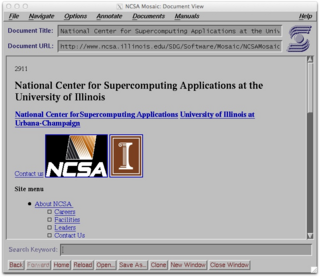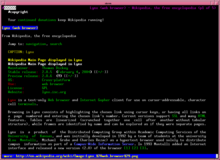The Gopher protocol is a communication protocol designed for distributing, searching, and retrieving documents in Internet Protocol networks. The design of the Gopher protocol and user interface is menu-driven, and presented an alternative to the World Wide Web in its early stages, but ultimately fell into disfavor, yielding to HTTP. The Gopher ecosystem is often regarded as the effective predecessor of the World Wide Web.

Links is a free software text and graphical web browser with a pull-down menu system. It renders complex pages, has partial HTML 4.0 support, supports color and monochrome terminals, and allows horizontal scrolling.

NCSA Mosaic is a discontinued web browser, and one of the first to be widely available. It was instrumental in popularizing the World Wide Web and the general Internet by integrating multimedia such as text and graphics. It was named for its support of multiple Internet protocols, such as Hypertext Transfer Protocol, File Transfer Protocol, Network News Transfer Protocol, and Gopher. Its intuitive interface, reliability, personal computer support, and simple installation all contributed to its popularity within the web. Mosaic is the first browser to display images inline with text instead of in a separate window. It is often described as the first graphical web browser, though it was preceded by WorldWideWeb, the lesser-known Erwise, and ViolaWWW.

A man page is a form of software documentation usually found on a Unix or Unix-like operating system. Topics covered include computer programs, formal standards and conventions, and even abstract concepts. A user may invoke a man page by issuing the man command.

Squid is a caching and forwarding HTTP web proxy. It has a wide variety of uses, including speeding up a web server by caching repeated requests, caching World Wide Web (WWW), Domain Name System (DNS), and other network lookups for a group of people sharing network resources, and aiding security by filtering traffic. Although used for mainly HTTP and File Transfer Protocol (FTP), Squid includes limited support for several other protocols including Internet Gopher, Secure Sockets Layer (SSL), Transport Layer Security (TLS), and Hypertext Transfer Protocol Secure (HTTPS). Squid does not support the SOCKS protocol, unlike Privoxy, with which Squid can be used in order to provide SOCKS support.

SQLite is a database engine written in the C programming language. It is not a standalone app; rather, it is a library that software developers embed in their apps. As such, it belongs to the family of embedded databases. It is the most widely deployed database engine, as it is used by several of the top web browsers, operating systems, mobile phones, and other embedded systems.
cURL is a computer software project providing a library (libcurl) and command-line tool (curl) for transferring data using various network protocols. The name stands for "Client for URL".
This is a comparison of both historical and current web browsers based on developer, engine, platform(s), releases, license, and cost.

The Line Mode Browser is the second web browser ever created. The browser was the first demonstrated to be portable to several different operating systems. Operated from a simple command-line interface, it could be widely used on many computers and computer terminals throughout the Internet. The browser was developed starting in 1990, and then supported by the World Wide Web Consortium (W3C) as an example and test application for the libwww library.

HTTP pipelining is a feature of HTTP/1.1, which allows multiple HTTP requests to be sent over a single TCP connection without waiting for the corresponding responses. HTTP/1.1 requires servers to respond to pipelined requests correctly, with non-pipelined but valid responses even if server does not support HTTP pipelining. Despite this requirement, many legacy HTTP/1.1 servers do not support pipelining correctly, forcing most HTTP clients to not use HTTP pipelining.
The blink element is a non-standard HTML element that indicates to a user agent that the page author intends the content of the element to blink. The element was introduced in Netscape Navigator but is no longer supported and often ignored by modern Web browsers; some, such as Internet Explorer, never supported the element at all.
Mozilla Firefox has features which distinguish it from other web browsers, such as Google Chrome, Safari, and Microsoft Edge.

NetSurf is an open-source web browser which uses its own layout engine. Its design goal is to be lightweight and portable. NetSurf provides features including tabbed browsing, bookmarks and page thumbnailing.

Libwww is an early World Wide Web software library providing core functions for web browsers, implementing HTML, HTTP, and other technologies. Tim Berners-Lee, at the European Organization for Nuclear Research (CERN), released libwww in late 1992, comprising reusable code from the first browsers.

Alpine is a free software email client developed at the University of Washington.
This is a comparison of notable free and open-source configuration management software, suitable for tasks like server configuration, orchestration and infrastructure as code typically performed by a system administrator.
A web browser is a software application for retrieving, presenting and traversing information resources on the World Wide Web. It further provides for the capture or input of information which may be returned to the presenting system, then stored or processed as necessary. The method of accessing a particular page or content is achieved by entering its address, known as a Uniform Resource Identifier or URI. This may be a web page, image, video, or other piece of content. Hyperlinks present in resources enable users easily to navigate their browsers to related resources. A web browser can also be defined as an application software or program designed to enable users to access, retrieve and view documents and other resources on the Internet.

Uzbl is a discontinued free and open-source minimalist web browser designed for simplicity and adherence to the Unix philosophy. Development began in early 2009 and is still considered in alpha software by the developers. The core component of Uzbl is written in C, but other languages are also used, most notably Python. All parts of the Uzbl project are released as free software under GNU GPL-3.0-only.

xombrero is a discontinued open-source web browser developed with a goal to be a lightweight and secure replacement for full featured browsers like Firefox. The browser has found a niche among minimalist browsers for heavy keyboard users by balancing minimalism with usability.














